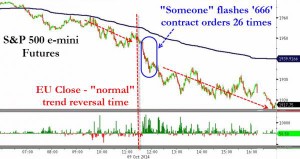Satan is now firmly in control of the markets.
No, we’re not talking about Ben Bernanke, aka Edward Quince. His time has passed. We’re talking about a high-frequency trader who also happens to be hell’s CEO.
 As evidence, consider Thursday’s market plunge. The Dow Jones Industrial Average (DJIA) fell 334.97 points, its largest loss of the year. The drop took place, as Zerohedge noted, after “ ‘someone’ canceled-and-replaced orders for 666 contracts 26 times in the 1130ET to 1200ET period,” after which “selling accelerated lower, no reversal, to close at the lows on heavy volume.”
As evidence, consider Thursday’s market plunge. The Dow Jones Industrial Average (DJIA) fell 334.97 points, its largest loss of the year. The drop took place, as Zerohedge noted, after “ ‘someone’ canceled-and-replaced orders for 666 contracts 26 times in the 1130ET to 1200ET period,” after which “selling accelerated lower, no reversal, to close at the lows on heavy volume.”
The number 666 is, of course, the winning number in hell’s lottery. To trade 666 contracts 26 times, you need a lot of capital in your account. Most traders would avoid using the devil’s number, but someone – or, more likely, some firm – was trying to make a statement.
What could it mean? That Satan is in charge, of course.
Good vs. Evil
Maybe, though, we need to consider the market drop in a broader context. The biggest market drop of the year followed by a day the biggest market gain of the year, a 274.89 DJIA boost … which was nearly matched by a drop on Tuesday of 272.58 points.
So maybe Beelzebub isn’t running things after all. Maybe it’s a classic struggle between good and evil. Whatever it is, the volatility index (VIX), which had practically flatlined, has suddenly come alive, jumping to 18.76. That’s still lower than its 20-year average of 20.8, but it’s a 24% jump in a single day (and it topped 22 this morning). It’s also noteworthy that it was the fourth largest trading day in the market’s history.
Other than the devil, you may be wondering what caused so much sudden volatility – and so much trading volume. A Russian invasion of Estonia? Another red line crossed? Release of the real GDP numbers for the second quarter? An ebola outbreak on Wall Street?
The answer? Nothing. “No news” was the real news. Just another case of HFT. 
The high-frequency traders apparently were getting bored and decided to have a little fun. For a good time, nothing beats manipulating the markets. And if you can make a lot of money while you’re having a little fun, why not?
As Michael Lewis has said, “The markets are rigged.” Here’s proof.
Other Rationalizations
Some analysts had other explanations for the market’s wild swings of the past week.
The predominant explanation, noted by The Wall Street Journal, is that slowing global growth, especially in Europe, is a concern. Europe isn’t as good at fudging numbers as the Bureau of Labor Statistics, but considering how slow growth has been for the past six years, how could anyone notice if it’s slowing?
Falling energy prices were cited as a secondary reason, but energy prices are falling because of slower global growth. And if energy prices fall, won’t consumers have more money to spend, which would boost the economy?
Expected increases in interest rates remain an ongoing concern, but that should have been last week’s news. Fed Chair Janet Yellen said that interest rates will remain low for “a considerable time” after the Fed’s bond-buying program ends and some are concerned that she didn’t define “considerable.” Three minutes could be a “considerable” time if you’re an amoeba.
However, setting a date on when interest rates will rise would have unintended consequences. It would be like setting a date for withdrawing troops from Iraq, which turned out to be a bad idea. It’s not good to show your hand to the Islamic State or to Satan.
